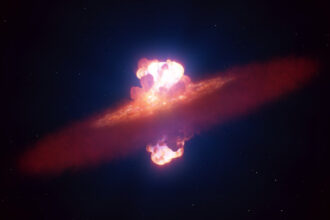Scientists have gotten to the bottom of the mystery of an “impossible” merger between black holes that was detected via ripples in space-time called gravitational waves back in 2023.
The collision occurred around 7 billion light-years away and involved a smashup of two black holes that seemed to be forbidden, because of their enormous masses and the incredible rate at which they were spinning.
These black holes — with masses of 100 and 140 times that of the sun, and spinning at near the speed of light — shouldn’t exist according to current theories of how “stellar mass black holes” form when massive stars collapse and explode as supernovae.

Researchers from the Flatiron Institute’s Center for Computational Astrophysics (CCA) in New York tackled this puzzle by performing simulations that recreated this system’s evolution through the lives of the progenitor stars, all the way to their supernova deaths. This revealed a simple factor that hadn’t been properly considered in the process before: magnetic fields.
“No one has considered these systems the way we did; previously, astronomers just took a shortcut and neglected the magnetic fields,” team leader Ore Gottlieb, an astrophysicist at the CCA, said in a statement. “But once you consider magnetic fields, you can actually explain the origins of this unique event.”
Not so impossible?
That’s because the stars that could die to leave behind stellar mass black holes as massive as these should end their lives with a specific type of supernova called a “pair-instability supernova” that’s so violent that nothing remains, not even a black hole.”As a result of these supernovae, we don’t expect black holes to form between roughly 70 to 140 times the mass of the sun,” Gottlieb explained. “So, it was puzzling to see black holes with masses inside this gap.”
Black holes can exist within that mass gap as the result of a previous merger between black holes, but researchers ruled this out for the black holes involved in the collision that sent the signal GW231123 rippling through space. That’s because mergers are disruptive to the spin of the created “daughter” black hole, but the two black holes involved in this merger were still spinning at near the speed of light, at the maximum speed at which black holes can rotate. Thus, researchers concluded that something other than prior mergers must account for the tremendous masses of the progenitor black holes.
Gottlieb and colleagues began investigating what this mechanism could be by first simulating a giant star with a mass of around 250 times that of the sun, which they tracked through its evolution right up until its supernova death. They found that, by this end stage, the star had burned through so much of its fuel that it had “slimmed down” to 150 solar masses. That left it small enough to leave behind a black hole after it went supernova.
The team then ran another, more complex simulation, factoring in magnetic fields that play a role in the aftermath of the supernova. This second model began with supernova remnants in the shape of a cloud of leftover stellar material intertwined with magnetic fields. At the heart of this wreckage sat a black hole. Prior to this research, scientists had assumed that the entire mass of this remnant material would be consumed by the newborn black hole. As a consequence, the mass of that black hole would grow to match the mass of the massive progenitor star. However, the team’s simulations showed something different happening.

What Gottlieb and colleagues observed instead was that, after the collapse of a nonrotating star to form a black hole, leftover material does indeed quickly fall into the black hole. But if the progenitor star is spinning rapidly, this stellar wreckage forms a rotating, flattened cloud around the newborn black hole that causes it to spin faster and faster as more and more material is fed to it. In the presence of magnetic fields, the disk of debris experiences pressure strong enough to blast some of the leftover matter away from the black hole at nearly the speed of light.
This outflow of material reduces the mass of the disk feeding the black hole, and the stronger the magnetic fields involved, the more rapidly this platter of stellar material is carried away from the black hole. If the magnetic fields are powerful enough, half of the star’s initial mass can be blasted away. The net result: a weak magnetic field results in less deprivation of matter and a final black hole that sits within the mass gap.
“We found the presence of rotation and magnetic fields may fundamentally change the post-collapse evolution of the star, making black hole mass potentially significantly lower than the total mass of the collapsing star,” Gottlieb said.
Beyond offering a solution to the puzzle of this “impossible” merger, the team’s simulations suggest a connection between the mass of a black hole and the rate at which it spins via the strength of the magnetic fields around it. Strong magnetic fields may result in lighter and slower-spinning black holes, while weaker magnetic fields could result in more massive and more rapidly spinning black holes.
The research may also suggest a way for astronomers to test this connection. The team found that the creation of these mass-gap black holes is associated with a burst of gamma rays, which are detectable. Should such a detection be made, scientists will have made a major step forward in our understanding of black holes.
The team’s research was published on Wednesday (Nov.12) in The Astrophysical Journal Letters.







